
Icterids or New World blackbirds make up a family, the Icteridae, of small to medium-sized, often colorful, New World passerine birds. The family contains 108 species and is divided into 30 genera. Most species have black as a predominant plumage color, often enlivened by yellow, orange, or red. The species in the family vary widely in size, shape, behavior, and coloration. The name, meaning "jaundiced ones" comes from the Ancient Greek ikteros via the Latin ictericus. This group includes the New World blackbirds, New World orioles, the bobolink, meadowlarks, grackles, cowbirds, oropendolas, and caciques.
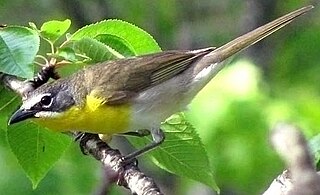
The yellow-breasted chat is a large songbird found in North America, and is the only member of the family Icteriidae. It was once a member of the New World warbler family Parulidae, but in 2017, the American Ornithological Society moved it to its own family. Its placement is not definitively resolved.

Cowbirds are birds belonging to the genus Molothrus in the family Icteridae. They are of New World origin, and are obligate brood parasites, laying their eggs in the nests of other species.

The giant cowbird is a large passerine bird in the New World family Icteridae. It breeds from southern Mexico south to northern Argentina, and on Trinidad and Tobago. It may have relatively recently colonised the latter island. It is a brood parasite and lays its eggs in the nests of other birds.

Oropendolas are a genus of passerine birds, Psarocolius, in the New World blackbird family Icteridae. They were formerly split among two or three different genera and are found in Central and South America.

The nine-primaried oscines is a group of bird families in the suborder Passeri (oscines) of the Passeriformes. The composition of the group has changed since the term was introduced but is now considered to consist of seven major families—Fringillidae, Emberizidae, Cardinalidae, Thraupidae, Passerellidae, Parulidae and Icteridae—plus some small families. When Fringillidae is omitted the remaining six families are referred to as the "New World" nine-primaried oscines.

Agelaius is a genus of blackbirds in the New World family Icteridae. Established by Louis Pierre Vieillot in 1816, it contains five species:

Agelasticus is a genus of birds in the New World oriole family Icteridae. They have slender forms and thin bills. The females are responsible for building the nest, unlike some of their close relatives. The genus is found in South America.

The yellow-winged blackbird is a species of bird in the family Icteridae. It is found in Argentina, Bolivia, Brazil, Chile, Paraguay, Peru, and Uruguay.

The yellow-hooded blackbird is a species of bird in the family Icteridae. It is found in grassy and brush areas near water in northern South America, and is generally fairly common. It is sexually dimorphic, and the genders resemble the respective genders of the larger yellow-headed blackbird of North America, though the male yellow-hooded blackbird lacks white in the wings.

Chrysomus is a genus of bird in the family Icteridae.

The casqued cacique, formerly the casqued oropendola, is a species of bird in the family Icteridae.

The austral blackbird is a species of bird in the family Icteridae. It is found in Argentina and Chile. Its natural habitats are temperate forests, subtropical or tropical high-altitude shrubland, and heavily degraded former forest.
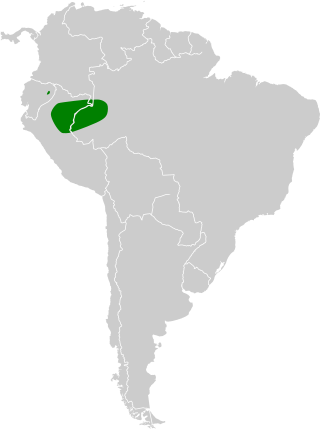
The band-tailed cacique, formerly the band-tailed oropendola, is a species of bird in the family Icteridae.

The yellow-rumped marshbird is a species of bird in the family Icteridae. It is a medium-sized bird found in Argentina, Brazil, Paraguay, and Uruguay, where its natural habitats are dry savanna, swamps, and pastureland.

The marshbirds, Pseudoleistes, are a small genus of icterid birds.
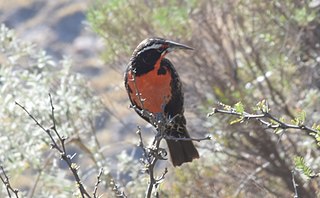
The Pampas meadowlark is a species of bird in the family Icteridae. It is found in Argentina, Brazil, and Uruguay.
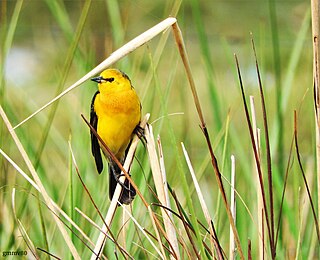
The saffron-cowled blackbird is a species of bird in the family Icteridae. It is the only species placed in the genus Xanthopsar. It has bright yellow underparts and black or dark brown upperparts. It is found in Argentina, Brazil, Paraguay, and in Uruguay at the Quebrada de los Cuervos. Its natural habitats are subtropical or tropical dry lowland grassland, subtropical or tropical seasonally wet or flooded lowland grassland, and pastureland. It is threatened by habitat loss.
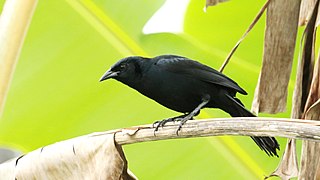
Dives is a genus of two Neotropical birds in the family Icteridae.

The baywings are two species of birds in the genus Agelaioides, which were described in the early 19th century. These species are found in Brazil and in the case of A. badius, also Argentina, Bolivia, Uruguay, and Paraguay. They were formerly in included in genus Molothrus with cowbirds.






















